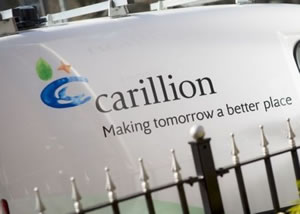Hounslow Takes Biggest Loss From Carillion of Any Borough
Council’s contingency plan shows cost of company’s failure was nearly £1.5 Million
Figures published this week in the National Audit Office’s (NAO) report into the failure of Carillion have revealed that the loss incurred by Hounslow will be the largest of any borough authority in the UK.
Hounslow were asked to forward a contingency plan to the (NAO) showing their preferred option in the event of liquidation. This showed that they estimated the cost to be £1,468,000. The only single local authority in the country with a higher figure was Oxfordshire County Council. The London Boroughs of Harrow and Ealing incurred cost of £2,617,000 for shared services they employed Carillion to fulfil. The largest cost of any organisation was for Network Rail who the report shows would lose £146 million in a ‘worst case’ scenario.
Carillion was a British company that provided facilities management and construction services. It operated in the UK, Canada and the Middle East and employed around 45,000 people. On 15 January this year the company declared insolvency and the Official Receiver started to liquidate its assets and contracts. At the time of liquidation it employed around 18,200 people in the UK and had around 420 contracts with the UK public sector. These included services for hospitals, schools, the armed forces, prisons and transport. By value, Carillion was central government’s sixth largest supplier. Public sector contracts accounted for 33% of Carillion’s total revenue and 45% of its UK revenue.
Carillion provided maintenance of Hounslow borough’s parks, allotments, cemeteries and open spaces. These were managed by Carillion until 1 March 2018, when management of these services was transferred to GreenSpace 360, a subsidiary of the council-owned trading company Lampton 360. As part of the transfer, Carillion staff responsible for managing these services became employees of GreenSpace 360 and four staff members became employees of Hounslow Council. The council met the demands of Price Waterhouse Cooper (PWC), who were acting as administrator, to pay Carillion weekly fees after it emerged that staff would not be paid in February unless the council made the additional payments. This followed advance payments made to Carillion for services in January and February as part of the Settlement Agreement. Some of the contingency cost incurred by Hounslow includes staff costs that may have needed to have been paid anyway but the Council say that the overheads payable to PWC were higher than they were used to with Carillion.
Councillor Steve Curran, Leader of Hounslow Council said, “Before Carillion went into involuntary liquidation the council had already agreed to terminate the Parks contract early with a transfer date of 9 April 2018 set. Due to the events that unfolded, the transfer was brought forward to 1 March 2018.
“Our priorities have always been the continuity of services for our residents and ensuring that former Carillion staff are treated fairly. I’m proud to say we achieved a seamless early transfer of these services and were able to offer jobs to former Carillion staff. ”
The Government had been monitoring Carillion as part of its risk management system for strategic suppliers. Up to August 2017, the Cabinet Office had rated Carillion as either green or amber since it started publishing its risk assessments in 2012. Since February 2016, Carillion had been rated as amber because of performance concerns. For several years the Cabinet Office had regularly raised with Carillion the issue of delayed payments to sub-contractors, and the short selling of its shares.
The scale of Carillion’s 10 July 2017 profit warning was a surprise to the government as Carillion’s 2016 accounts published in March 2017 showed the company as profitable and solvent. The Cabinet Office raised its risk rating of Carillion to red in September 2017 in response to the July profit warning but did not raise Carillion’s rating to its highest risk category before it collapsed. Following the change in risk rating Hounslow Council had decided to transfer the services in November 2017 with the process to be completed by April 2018. They had already taken the contract to manage the borough’s libraries in house in the summer of 2017, six years before the contract was due to end.
At the same time that the risk rating on Carillion was increased the Cabinet Office was accelerating coordination of contingency planning in the event of Carillion’s failure, a process which started in July 2017. They received 65 contingency plans from 26 public bodies including Hounslow but some of these were uncosted (although none of the uncosted plans were from local authorities).
Following a further profit warning in November 2017, the Cabinet Office wrote to Carillion to say that it proposed rating Carillion as its highest risk. Carillion replied this move would risk precipitating its collapse and the Cabinet Office accepted this argument.
Carillion announced £1.9 billion of new government work after the July profit warning. HS2 Ltd approved two joint venture contracts worth £1.3 billion before 10 July but signed them afterwards. Network Rail confirmed the next phase of one contract worth £63 million after the second profit warning in September. In total eight contracts and variations were announced. In all but one case joint venture partners were obliged to finish the contracts if Carillion failed.
June 8, 2018
